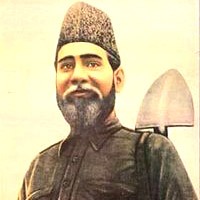The Khaksar Movement was a paramilitary organization, which was introduced by Allama Inayatullah Mashriqi in a chaotic situation of the political atmosphere of India. After serving for about 17 years in the education department, in 1931, he proceeded to launch a movement to transform the Muslims into well-organized and disciplined force. Earlier in 1926, he had seen Hitler and his Mein Kampf, which impressed him so much and lingered on in his mind. The movement was absolutely non-political though partially based on military basis with aims and objectives undefined for long time. It was assumed to be a social-reformist movement, which had to deal with the objectives set by its founder. The membership was open to everyone with no membership fee irrespective of any caste, color or creed. The organization needed dedicated and selfless people as the founder rejected all those who wanted to join party for their vested interests. The party workers were required to bear their own expenses, and spare time for work of social welfare of the community. The Khaksars mean humble people who had to wear ‘Khaki’ uniform due to its matching with the color of the earth having word ‘Akhuwat’ (brotherhood) on their sleeves. They carried in their right hand a ‘bailcha’ (shovel) which is used for leveling of ground and was a symbol to level the society for equity and equality and remove the existing division of the rich and the poor. The volunteers had to participate daily in military parade and social work without any hesitation.
The organization of the movement was such that Allama Mashriqi was Khaksar-i-Azam (the biggest khaksar) with an advisory council but Allama could overrule any advice. He was entitled to remove any member from the organization while there was no way to remove him. The focal point of the movement was social reforms but it actively participated in politics and the leaders came in working alliance with Muslim League, as League was the only organization, which Khaksars were liable to join. Whenever Allama asked the Khaksars to move from one place to another for public service or called them for a convention/meeting, they followed in unison his orders willingly and most obediently day or night at any time. Their activities for social welfare expanded from Punjab to Sind, Baluchistan and NWFP. The movement had a strong tendency towards the liberation of India from foreign rule but it did not establish cordial relations with any political organization of that period. Due to party’s rigid manifesto and strictness to its ideology the Khaksar leaders including Allama Mashriqi remained in jails for longer period of time. Drilling and parading in playgrounds, streets and neighborhoods Khaksars were seen clad in khaki uniform with spades upon their shoulders. These militant activities, however, brought him indirect conflict with the government of the day. On February 28, 1940, the Punjab premier Sir Sikandar Hayat Khan imposed restrictions on the Khaksar activities. On 19 March 1940, the police opened fire on the Khaksars parading in protest. Many of them were killed or injured while Mashriqi and so many were imprisoned. It is said that in the session in which the Pakistan Resolution was passed by the Muslim League, a condolence resolution was also presented. It placed ‘on record its deep sense of sorrow at the unfortunate and tragic occurrence on the 19th of March, 1940, owing to a clash between the Khaksars and the police’. The Session called upon the Government forthwith to appoint an independent and impartial committee of inquiry with instructions to make complete investigation and inquiry in the whole affair, and make their report as soon as possible. Mashriqi who was kept in jail without any legal proceedings had fasted to the point of death in order to obtain his release and that of his followers. The Government of India at the time kept Mashriqi’s fasting a secret. However, the news was leaked out and Mashriqi along with so many Khaksars had to be released on January 19, 1942 but his movements were kept restricted to Madras. Egged on by some of the Madras Congressmen, Allama Mashriqi issued instructions to the Khaksars to adopt every means to influence the Quaid-i-Azam and make him realize the so-called importance of oneness (unity of India). Consequently a Khaksar from the Punjab found an occasion to assault the Quaid with a knife on 26 July 1943.
The final show of Khaksar was against Muslim League council session in June 1947 at Imperial Hotel Delhi to occupy the floor and to use force to reject the partition plan. But it did not succeed. The movement attracted many Indian Muslims before the partition but after the division it lost its sympathizers due to the failure of party program and its ideology. Khaksar tehreek soon began to shrink and gradually lost its popularity. However after independence, Khaksar movement changed into a civilian political group and comprised PNA (Pakistan National Alliance) in 1977.
This article was last updated on Monday, Jan 01, 2007






